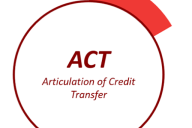You have /5 articles left.
Sign up for a free account or log in.
While the mainstream media may continue to portray college students as a monolithic group of recent high school graduates who live on campus and enroll full-time, the field has moved on to a far more nuanced understanding of today’s students as “post-traditional.” Thanks to the research and efforts of many groups, like Lumina Foundation and the American Council on Education, we know that students today increasingly lead complex lives as they work their way through college, balance school with parenting and other time commitments, and struggle to pay for the full costs of attendance. The pandemic has only exacerbated these complexities, and they are at the forefront as institutional and policy leaders devise new strategies to help students enroll and stay on track.
Yet, for all the progress we have made to recognize the diverse needs of today’s students, conversations on transfer student success often continue to center the experiences of "traditional” transfer students -- that is, students who enroll directly in community college and who transfer in a linear fashion to a four-year institution. While vertical transfer is critical to address, especially when we consider the high volume of students who pursue this pathway and the mobility opportunities presented by strengthening this pathway, a significant share of students actually transfer laterally or otherwise move across a range of institutions.
For example, a study on student mobility by the National Student Clearinghouse found that almost 38 percent of students who start at a four-year institution end up transferring to another four-year or to a community college, on par with the 37 percent who start at a two-year institution and transfer to another institution. Moreover, of students who transfer, 45 percent transfer more than once. Regardless of the direction that students move, they should (rightfully) expect to keep the credits they earn.
We could go on. But the point is that transfer today is the norm and it is often not a straight line, with many students accumulating credits across numerous institutions over longer timelines. This complexity is only heightened as the options for learning experiences available to students expand, effectively causing more students to “transfer” learning and credit as they move across K-12, postsecondary education and the workplace.
Already, there are more than 690,000 different postsecondary credentials in the United States -- and those numbers are growing rapidly as education providers experiment with new models. Skills boot camps, badges and other microcredentials are growing, alongside new industry-recognized certifications created by Google, Amazon, IBM and the like. We’re seeing heightened interest in competency-based education models that allow students to move through content at their own pace, rather than adhering to traditional academic term start and end dates. A third of students seek further scheduling flexibility by taking one or more courses online, often picking up online classes from outside their home institution. And both recent high school graduates and working adults are entering higher education with previous college-equivalent learning completed -- over one-third of students complete postsecondary credit in high school (through dual enrollment or AP courses), and an unknown share of working adults have relevant on-the-job training and work-based learning that must be assessed for college credit at entry.
Collectively, these changing trends in how students access learning should facilitate students’ entry to higher education and help them reach a degree or credential more quickly. But this requires transfer policies and institutional practices that keep up with the pace of change and adapt to the new needs of learners today.
This raises two fundamental questions for higher education leaders and policy makers:
- How do we capture and count student learning so that when students move through work and education, they do not lose ground?
- How do we craft policy and practice solutions that are laser-focused on equitable education and career outcomes for Black, Latinx and Indigenous students and students from low-income backgrounds?
These are the questions that a group of experienced practitioners and policy experts -- the Tackling Transfer Policy Advisory Board -- will address through its forthcoming state and federal policy framework. This framework will chart a new vision for transfer and address key challenges, such as how to:
- Design the right mix of financial incentives and infrastructure to drive institutional behavior in ways that ensure transfer students are supported and their credits apply to completion of their major;
- Address transfer students' comprehensive financial needs through state and federal financial aid;
- Leverage technology to serve growing numbers of students and accelerate the speed, accuracy and fairness of credit evaluation and transcription, including credit for learning acquired in a variety of settings; and
- Elevate data in ways that shine a light on inequities in the current system, particularly for Black, Latinx and Indigenous students and students from low-income backgrounds.
Digging into questions around how to make all learning count is the essential first step to modernizing transfer. With institutions across the country seeing both transfer and first-time enrollments fall significantly amid COVID-19, we must move quickly to design solutions that meet learners where they are. Only then can we expect to make progress on closing attainment gaps for transfer students.


